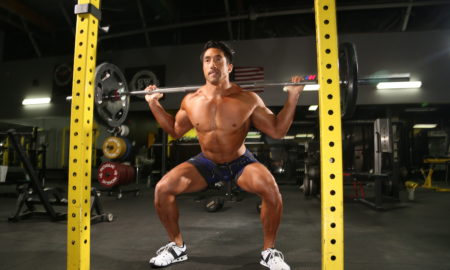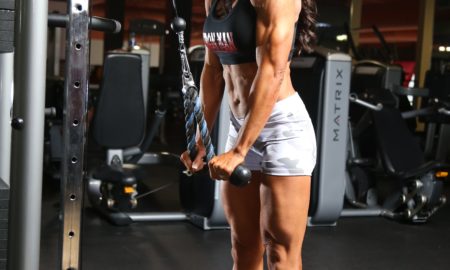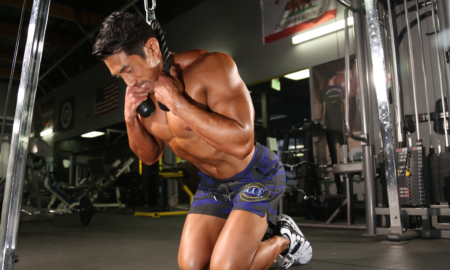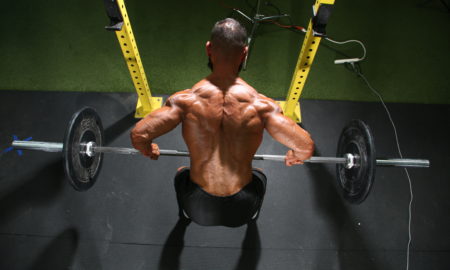
Calf training involves many components. Common exercises include standard standing calf raises, leg press calf raises and donkey calf raises performed in various toes-in and toes-out positions. Most serious trainees also do seated calf raises.
The anatomy and functions of the calf muscles are quite interesting. The main muscle is the gastrocnemius. Most trainees refer to it as the calf, and some call it the upper-calf muscle. The gastrocnemius originates on the lower femur, a.k.a. the thigh bone, and inserts on the ankle via the Achilles tendon. The second muscle in the calf group is the soleus, which is commonly referred to as the lower calf. The soleus originates on the tibia, the larger lower-leg bone, and shares the Achilles tendon with the gastroc. Unlike the gastrocnemius, the soleus doesn’t cross the knee joint.
I’ve discussed two-joint muscles in several installments of this column. A two-joint muscle is one that crosses two joints and has an effect on both. The positions of the joints are critical to its function. To be fully recruited, a muscle must be stretched at both joints. That applies to the gastroc, which is a two-joint muscle. It flexes the knee, bending it, and the plantar flexes the ankle, pointing the foot downward. The gastroc is maximally recruited when your knee is extended, or straight, and the ankle is “dorsiflexed,” with your toes pointed upward. The best exercises for that are the standing calf raise, donkey calf raise and leg press calf raise.
If the knee is flexed, the gastroc is recruited less but not eliminated from the action. The soleus is a one-joint muscle, and it only plantar flexes the ankle. So, during seated calf raises, when the knees are bent and gastroc recruitment is decreased, the one-joint soleus isn’t affected. Consequently, trainees often emphasize seated calf raises to target the lower calf.
Two other muscles are worked during calf training. The first is the peroneus group, which is commonly referred to as the outer calf and which adds to an impressive lower-leg appearance if it’s developed. The muscles attach to the fibula, the smaller lower-leg bone, and insert into the ankle. Their function is to plantar flex the ankle and turn it outward. The peroneus group is a one-joint muscle group and is also targeted with seated calf raises. It’s often injured in ankle sprains in which the ankle rolls inward.
Another one-joint muscle that’s part of the calf structure, the posterior tibialis, originates on the tibia and inserts into the lower ankle. Its function is to plantar flex the ankle and turn it inward. If it becomes overstretched, then the ankle will lose dynamic support and may develop pain. The foot and ankle may begin to collapse inward and can be quite uncomfortable. Seated calf raises work this muscle significantly, but if it’s overstretched, exercise may cause pain. If you have pain when performing seated or standing calf raises, stop doing the exercises and see a health-care professional to have the problem evaluated. Don’t be afraid to ask him or her to answer a few questions about the foot and ankle.
According to orthopedic surgeon Carol Frey, M.D., who specializes in the foot and ankle at her practice in Manhattan Beach, California, and consults for Nike, the cartilage lining can withstand double your bodyweight. Further increases can cause water to leak out of the cartilage, which leads to degenerative changes. In addition, the increased poundage is very hard on the posterior tibialis and peronei muscles and may cause them to overstretch and give way.
Most people use a lot more poundage than double their bodyweight on calf exercises. We don’t know what the effect of doing that for a decade will have on the human body. Perhaps, as today’s trainees age and seek health care, we’ll learn more about the long-term effect of such training and whether there are any significant harmful changes.
I advise against performing an excessive number of sets of seated calf raises. Use the standing calf machine, donkey calf raise and/or leg press calf raise for the majority of your calf work and then just add a few sets of seated calf raises. That strategy may well save the supporting muscles in your ankle. IM
Editor’s note: Visit www.SoftTissueCenter.com for reprints of Horrigan’s past Sportsmedicine columns that have appeared in IRON MAN. You can order the books, Strength, Conditioning and Injury Prevention for Hockey by Joseph Horrigan, D.C., and E.J. “Doc” Kreis, D.A., and the 7-Minute Rotator Cuff Solution by Horrigan and Jerry Robinson from Home Gym Warehouse, (800) 447-0008 or at www.Home-Gym.com.




















You must be logged in to post a comment Login